Service layer configuration scenarios
So far we've established a relatively clean service layer model for SOA, in which logic is clearly abstracted through three distinct layers that establish a well-defined composition hierarchy. Unfortunately, real SOAs rarely resemble this state.
Many variations can exist, as the various types of services we've discussed so far can be combined to create different SOA configurations. We provide here some sample configuration scenarios and briefly discuss the characteristics of each.
Just to recap, we will explore scenarios based on the use of the following types of services:
- hybrid application services (services containing both business process and application logic)
- utility application services (services containing reusable application logic)
- task-centric business services (services containing business process logic)
- entity-centric business services (services containing entity business logic)
- process services (services representing the orchestration service layer)
Note
In this section we qualify application services with the terms "hybrid" and "utility." However, in future chapters, utility application services simply are referred to as application services.
9.7.1. Scenario #1: Hybrid application services only
When Web services simply are appended to existing distributed application environments, or when a Web services-based solution is built without any emphasis on reuse or service-oriented business modeling, the resulting architecture tends to consist of a set of hybrid application services (Figure 9.7).
Figure 9.7. Hybrid services encapsulating both business and application logic.
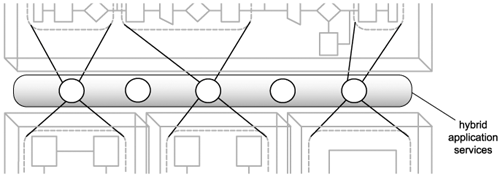
9.7.2. Scenario #2: Hybrid and utility application services
A variation of the previous configuration establishes a Web services-based architecture consisting of hybrid services and reusable application services. In this case, the hybrid services may compose some of the reusable application services. This configuration achieves an extent of abstraction, as the utility services establish a solution-agnostic application layer (Figure 9.8).
Figure 9.8. Hybrid services composing available utility application services.
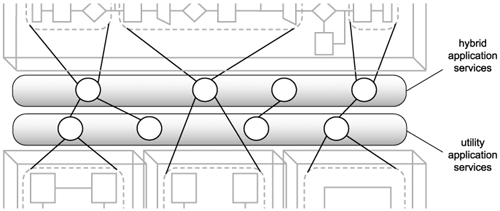
9.7.3. Scenario #3: Task-centric business services and utility application services
This approach results in a more coordinated level of abstraction, given that business process logic is entirely represented by a layer of task-centric business services. These services rely on a layer of application services for the execution of all their business logic (Figure 9.9).
Figure 9.9. Task-centric business services and utility application services cleanly abstracting business and application logic.
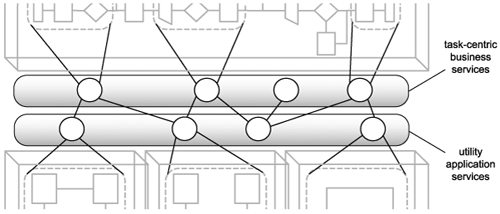
9.7.4. Scenario #4: Task-centric business services, entity-centric business services, and utility application services
Here we've added a further layer of abstraction through the introduction of entity-centric business services. This positions task-centric services as parent controllers that may compose both entity-centric and application services to carry out business process logic (Figure 9.10).
Figure 9.10. Two types of business services composing application services.
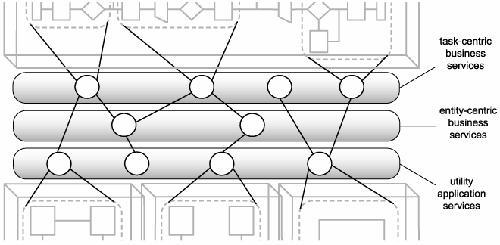
9.7.5. Scenario #5: Process services, hybrid application services, and utility application services
In this scenario, a parent process service composes available hybrid and application services to automate a business process. This is a common configuration when adding an orchestration layer over the top of an older distributed computing architecture that uses Web services (Figure 9.11).
Figure 9.11. An orchestration layer providing a process service that composes different types of application services.
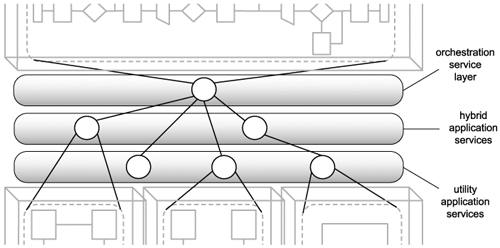
Note that although the hybrid service is being composed by the process service in Figure 9.11, the hybrid service still contains embedded business logic and therefore indirectly represents some of the business logic layer. Note also that the orchestration layer also may compose utility application services directly.
9.7.6. Scenario #6: Process services, task-centric business services, and utility application services
Even though task-centric services also contain business process logic, a parent process service can still be positioned to compose both task-centric and utility application services. Though only partial abstraction is achieved via task-centric services, when combined with the centralized business process logic represented by the process services, business logic as a whole is still abstracted (Figure 9.12).
Figure 9.12. A process service composing task-centric and utility application services.
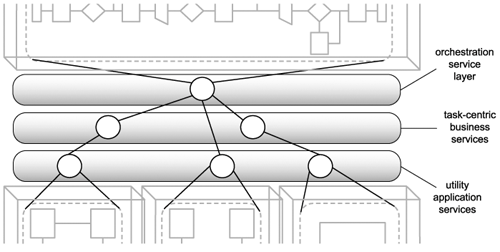
9.7.7. Scenario #7: Process services, task-centric business services, entity-centric business services, and utility application services
This variation also introduces entity-centric business services, which can result in a configuration that actually consists of four service layers. Sub-processes can be composed by strategically positioned task-centric services, whereas the parent process is managed by the process service, which composes both task-centric and entity-centric services (Figure 9.13).
Figure 9.13. Process and business services composing utility application services.
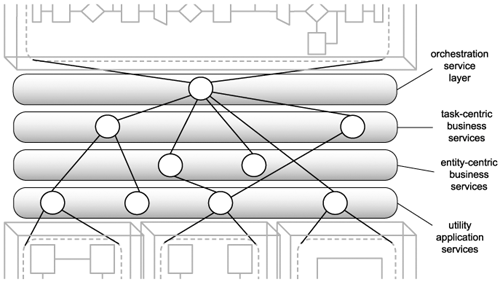
9.7.8. Scenario #8: Process services, entity-centric business services, and utility application services
This SOA model establishes a clean separation of business and application logic, while maximizing reuse through the utilization of solution and business process-agnostic service layers. The process service contains all business process-specific logic and executes this logic through the involvement of available entity-centric business services, which, in turn, compose utility application logic to carry out the required tasks (Figure 9.14).
Figure 9.14. A process service composing entity-centric services, which compose utility application services.

|
SUMMARY OF KEY POINTS |
|---|
|
Introduction
- Why this book is important
- Objectives of this book
- Who this book is for
- What this book does not cover
- How this book is organized
- Additional information
Case Studies
- Case Studies
- How case studies are used
- Case #1 background: RailCo Ltd.
- Case #2 background: Transit Line Systems Inc.
Part I: SOA and Web Services Fundamentals
Introducing SOA
- Introducing SOA
- Fundamental SOA
- Common characteristics of contemporary SOA
- Common misperceptions about SOA
- Common tangible benefits of SOA
- Common pitfalls of adopting SOA
The Evolution of SOA
- The Evolution of SOA
- An SOA timeline (from XML to Web services to SOA)
- The continuing evolution of SOA (standards organizations and contributing vendors)
- The roots of SOA (comparing SOA to past architectures)
Web Services and Primitive SOA
- Web Services and Primitive SOA
- The Web services framework
- Services (as Web services)
- Service descriptions (with WSDL)
- Messaging (with SOAP)
Part II: SOA and WS-* Extensions
Web Services and Contemporary SOA (Part I: Activity Management and Composition)
- Web Services and Contemporary SOA (Part I: Activity Management and Composition)
- Message exchange patterns
- Service activity
- Coordination
- Atomic transactions
- Business activities
- Orchestration
- Choreography
Web Services and Contemporary SOA (Part II: Advanced Messaging, Metadata, and Security)
- Web Services and Contemporary SOA (Part II: Advanced Messaging, Metadata, and Security)
- Addressing
- Reliable messaging
- Correlation
- Policies
- Metadata exchange
- Security
- Notification and eventing
Part III: SOA and Service-Orientation
Principles of Service-Orientation
- Principles of Service-Orientation
- Service-orientation and the enterprise
- Anatomy of a service-oriented architecture
- Common principles of service-orientation
- How service-orientation principles inter-relate
- Service-orientation and object-orientation (Part II)
- Native Web service support for service-orientation principles
Service Layers
- Service Layers
- Service-orientation and contemporary SOA
- Service layer abstraction
- Application service layer
- Business service layer
- Orchestration service layer
- Agnostic services
- Service layer configuration scenarios
Part IV: Building SOA (Planning and Analysis)
SOA Delivery Strategies
- SOA Delivery Strategies
- SOA delivery lifecycle phases
- The top-down strategy
- The bottom-up strategy
- The agile strategy
Service-Oriented Analysis (Part I: Introduction)
- Service-Oriented Analysis (Part I: Introduction)
- Service-oriented architecture vs. Service-oriented environment
- Introduction to service-oriented analysis
- Benefits of a business-centric SOA
- Deriving business services
Service-Oriented Analysis (Part II: Service Modeling)
- Service-Oriented Analysis (Part II: Service Modeling)
- Service modeling (a step-by-step process)
- Service modeling guidelines
- Classifying service model logic
- Contrasting service modeling approaches (an example)
Part V: Building SOA (Technology and Design)
Service-Oriented Design (Part I: Introduction)
- Service-Oriented Design (Part I: Introduction)
- Introduction to service-oriented design
- WSDL-related XML Schema language basics
- WSDL language basics
- SOAP language basics
- Service interface design tools
Service-Oriented Design (Part II: SOA Composition Guidelines)
- Service-Oriented Design (Part II: SOA Composition Guidelines)
- Steps to composing SOA
- Considerations for choosing service layers
- Considerations for positioning core SOA standards
- Considerations for choosing SOA extensions
Service-Oriented Design (Part III: Service Design)
- Service-Oriented Design (Part III: Service Design)
- Service design overview
- Entity-centric business service design (a step-by-step process)
- Application service design (a step-by-step process)
- Task-centric business service design (a step-by-step process)
- Service design guidelines
Service-Oriented Design (Part IV: Business Process Design)
- Service-Oriented Design (Part IV: Business Process Design)
- WS-BPEL language basics
- WS-Coordination overview
- Service-oriented business process design (a step-by-step process)
Fundamental WS-* Extensions
- Fundamental WS-* Extensions
- You mustUnderstand this
- WS-Addressing language basics
- WS-ReliableMessaging language basics
- WS-Policy language basics
- WS-MetadataExchange language basics
- WS-Security language basics
SOA Platforms
Appendix A. Case Studies: Conclusion
EAN: 2147483647
Pages: 150
